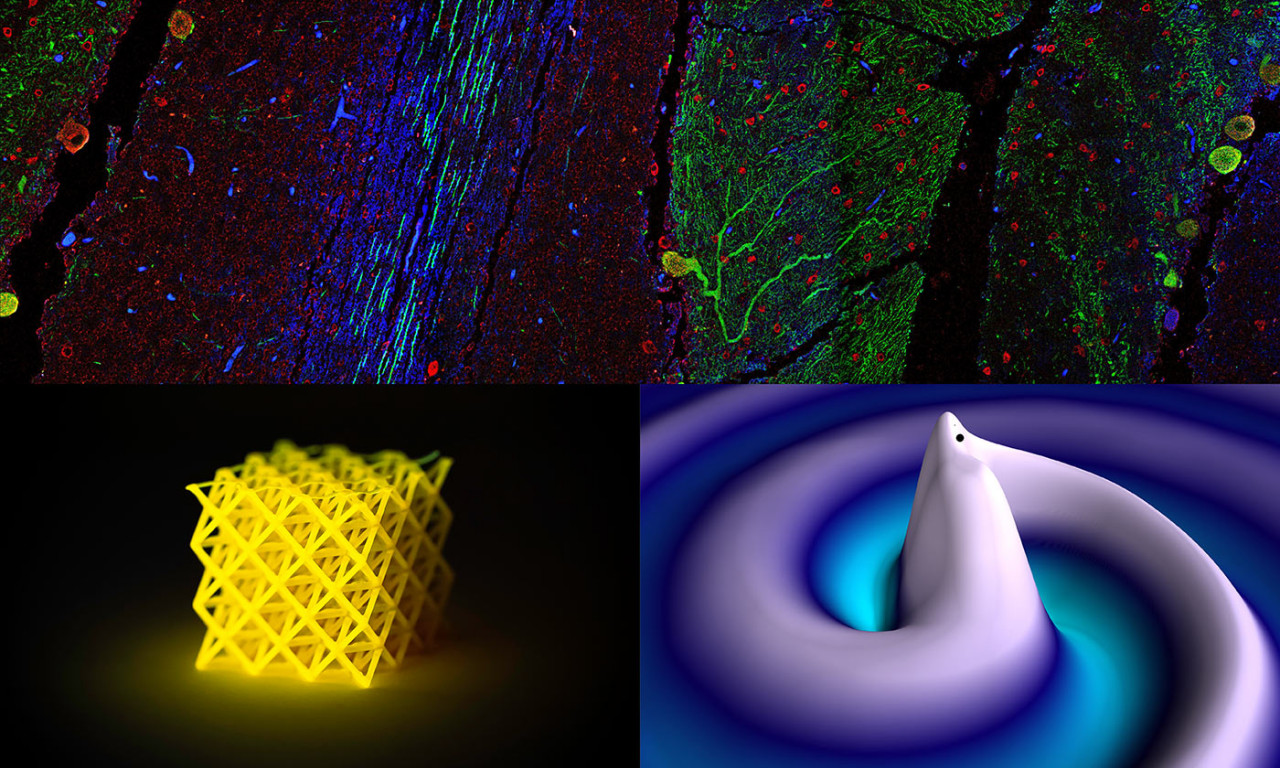Visualizing Science 2021: Finding the Art in College Research

The College of Natural Sciences again invited its faculty, staff and students to submit the best images from their research for our Visualizing Science competition. The images they delivered are the ones that spoke to their creators, offering both inspiration and information as they conducted their scholarly investigations during a challenging year.
From data visualizations to models of theoretical concepts, imagery often goes hand-in-hand with scientific discovery. Florence Nightingale created sophisticated rose charts to illustrate how simple sanitation practices could save lives. Rosalind Franklin used X-ray crystallography to reveal the elegant structures of viruses and DNA. NASA's New Horizons mission, led by alumnus Alan Stern, produced unprecedented views of the surface of Pluto and its satellites. And the lab of UT scientist Jason McLellan created the first 3D atomic scale map of the SARS-CoV-2 spike protein, which helped lead to the first COVID-19 vaccines.
Often these visual creations contain an inherent beauty all their own. This year's Visualizing Science submissions strive for that moment where science and art become one.
The finalists, six of the most outstanding submissions from our scientific community, were chosen based on their beauty and scientific merit. The seventh image is our Facebook Favorite, which was chosen by the community weighing in on submissions on the college Facebook page.
The College unveiled this year's winning images in our Visualizing Science Showcase, a 3D virtual gallery exhibition featuring not only the winning images, but finalists from previous years and a selection of other entries from this year. Take a stroll through the virtual gallery at the bottom of this page.
Now, without further ado, we proudly present the winners of the 2021 Visualizing Science competition:
First Place
This work was done as part of a project on neurodegeneration of the cerebellum with members of Dr. Tanya Paull's laboratory. Each layer of the cerebellum can be seen in this tissue slice from a study of patients with Ataxia-Telangiectasia (A-T), an early childhood onset neurodegenerative disorder specific to the cerebellum. The green cell in the center is a Purkinje neuron, a cell that integrates thousands of impulses from neighboring granule cells (seen in red here) to control movement and coordination in humans. In this study (Lee, et al., Molecular Cell 2021) the team investigated the role of poly-ADP-ribosylation in the disorder and found that higher levels occur in A-T patients.
The image was taken by Oshadi Wimalarathne with assistance from Dr. Collene Jeter at the UT MD Anderson Cancer Center, using formalin-fixed autopsy tissue obtained from the NIH Neurobiobank, prepared by Nicolette Ender. Preparation of the sample was done on the UT Austin main campus, with imaging at MD Anderson, Smithville, in the Flow Cytometry and Cellular Imaging core.
— Dr. Tanya Paull, Professor; Oshadi Wimalarathne, Research Scientist Assistant; and Nicolette Ender, Laboratory Manager/Research Technician. All are from the Department of Molecular Biosciences.
Second Place
This is a photograph of a three-dimensional lattice composed of polyacrylate. It was printed with a custom-made 3D digital light projection (DLP) printer, designed by Monoware for UT's Page laboratory, using visible light. A novel chemical photocatalyst synthesized in the lab was dissolved in a liquid resin, causing polymerization (solidification) when excited with visible light. This catalytic system and process allows us to realize complex solid objects from simple liquid starting materials.
In this photo the 3D printed lattice is fluorescing under longwave ultraviolet light due to the BODIPY catalyst being "trapped" in the solidified resin. To read more about the chemistry showcased in this photograph, read the research group's publication.
— Lynn Stevens, Chemistry Graduate Student
Third Place
The merger of two black holes is among the most violent and energetic events known to exist, the effects of which can be felt across the universe. Employing Einstein's theory of gravity, scientists can computationally solve for the behavior of these mergers as pictured here. This image shows a snapshot of two black holes of different mass orbiting one another, producing massive ripples in space-time known as gravitational waves. By the time these waves reach us, their amplitudes have decayed to be nearly imperceptible. However, gravitational wave detectors such as the Laser Interferometer Gravitational-Wave Observatory can detect these signals, giving us a new lens through which to observe the universe.
—Dr. Deborah Ferguson, Postdoctoral Fellow, Center for Gravitational Physics
Honorable Mentions
The vocal folds of the larynx (voice box) are critical for modulating speech, and therefore communication. They also serve as a physical barrier between the trachea and esophagus, enabling air to pass through the trachea, and food and water to pass through the esophagus. Because of this, birth defects of the larynx such as laryngeal webbing and tracheo-laryngomalacia not only cause problems in speaking, but often co-occur with severe feeding and respiratory issues in infants. Despite the life-threatening nature of these malformations, the molecular etiology of these defects, and indeed early vocal fold development, is unknown.
Two days into larynx development in a mouse embryo, scientists visualized tendon (green) and cartilage (red) progenitor cells forming the rudimentary vocal folds. The presence of these green cells suggests that early tendon precursors contribute in a major way to shaping and perhaps specifying mature vocal fold structures.
— Janani Ramachandran, Cell and Molecular Biology Graduate Student
In the cold predawn hours of December 14, 2020, the Hobby-Eberly Telescope (HET) at McDonald Observatory was open to the universe during the Geminid meteor shower. Of the 390 pictures captured during a 2-hour period, 57 images exhibiting visible meteors were combined. The resulting image shows all observed meteors and demonstrates the path that stars take around the north celestial pole as the Earth rotates. The gaps in these star trails visualize the time between each meteor event.
During this period, the Hobby-Eberly Telescope's enclosure was stationary while it surveyed a specific area of the sky for HETDEX, or the Hobby-Eberly Telescope Dark Energy Experiment. This ambitious project uses the HET's 10-meter mirror to collect the light from many stars and galaxies simultaneously into over 100 spectrographs using thousands of fiber optic cables. By the end of the survey, HETDEX will have the spectral data for more than 1 million galaxies in hopes of illuminating the mystery of Dark Energy.
— Justen Pautzke, HET Observer, McDonald Observatory
This is an image generated by simulating a modified version of a mathematical process called Conway's Game of Life. In it, one imagines an infinite grid on which organisms are allowed to live, but not move. Each pixel represents an organism and it lives or dies based on how many alive organisms are neighbors to it. At each time step, the vitality of each organism (indicated by the pixel's color) is updated according to these rules. Though the rules are simple, the resulting patterns that arise can be amazingly complex and unpredictable. John Conway's initial formulation of these processes, called cellular automata, was motivated by their implications in theoretical computer science and based on previous work by von Neumann and Ulam. He expected that cellular automata should exhibit a kind of "universal" behavior that allowed them to simulate any kind of computation through their patterns. My motivation to study them was to investigate how certain modifications to the rules can produce automata that have intricate geometric properties, such as fractal structure and chaotic behavior. This figure is in part dedicated to the late John Conway, who was a prolific mathematician and contributed this and much more to the world of mathematics.
— George D. Torres, Mathematics Graduate Student
Facebook Favorite
Witnessing the Birth of a Baby Planet: The first image captured by the Hubble Space Telescope of the newborn exoplanet PDS70b, orbiting a young star approximately 370 light years away from Earth. Undergraduate researcher Aniket Sanghi applied a technique called angular differential imaging to systematically remove contamination from the host star's light to uncover the nearly 1000 times fainter planet, seen bottom left in the image. The host star's position relative to the planet is marked with a white asterisk. The black circle masks the host star's residual light. Cardinal directions north and east are shown on the top right as arrows. The young planet is actively accreting mass onto itself. This high-fidelity detection enables the detailed characterization of its underlying formation mechanisms.
— Aniket Sanghi, Astronomy and Physics Undergraduate Student



